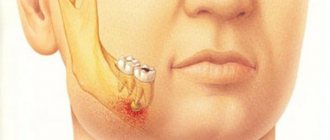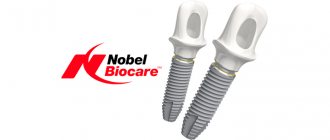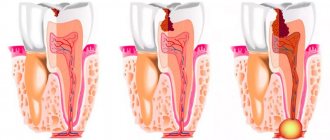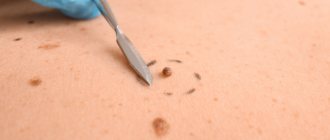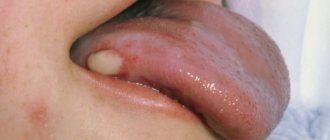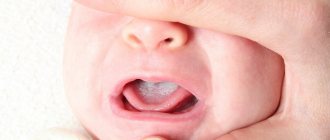Otitis – a disease accompanied by severe (both shooting, pulsating or aching) pain in the ears. Pain from otitis media can radiate to the teeth, temple, the corresponding side of the head and the back of the head. The patient experiences weakness, insomnia, and loss of appetite.
Depending on the nature of the disease, otitis media can occur in acute and chronic forms.
Acute otitis media is severe and characterized by severe pain.
1
Audiometry in MedicCity
2 Flushing the ear canals
3 Diagnosis of otitis in MedicCity
Acute otitis is a signal for the patient that it is necessary to urgently consult a doctor! Acute ear pain cannot be tolerated; it can cause deafness! Chronic otitis of the ear is less pronounced, but also very dangerous! Otitis media does not go away on its own; after otitis media, the patient may lose hearing forever, so at the first signs of the disease, you should urgently contact a specialist.
Types of otitis
Depending on the direction of the pain, it is customary to distinguish 3 types of otitis: external, middle and internal otitis.
Otitis externa most often appears as a result of mechanical damage to the auricle or external auditory canal. The following symptoms are characteristic of external otitis of the ear: aching, dull pain, swelling of the ear, and a slight increase in temperature.
Otitis of the middle ear is an inflammatory disease of the air cavities of the middle ear: the tympanic cavity, the auditory tube and the mastoid process.
Internal otitis is untreated otitis media of the middle ear. With internal otitis, inflammation of the inner ear occurs and the entire vestibular apparatus is damaged.
Sensorineural hearing loss
The cause of hearing loss and a feeling of fullness in the ears may be sensorineural hearing loss, which occurs as a result of a violation of the blood supply or innervation in the inner ear.
Sensorineural hearing loss can result from:
- changes in blood pressure due to hypertension;
- acute viral diseases;
- barotrauma;
- fracture of the base of the skull;
- ischemia of the central areas of the auditory analyzer;
- neuroma of the vestibulocochlear nerve;
- compression from the outside by neoplasms and vascular aneurysms.
Acute otitis media
According to statistics, acute forms of otitis media account for 30% of the total number of ENT diseases. Most often it occurs in preschool children.
Symptoms of acute otitis media
The disease is characterized by an acute onset with the appearance of the following symptoms:
- earache;
- ear congestion or hearing loss;
- increased body temperature;
- anxiety;
- disturbance of appetite, sleep;
- headache and toothache.
Causes of development of acute otitis media
In most cases, the disease can be caused by various pathogenic microorganisms - viruses, microbes, fungi, etc. In exudate obtained from the middle ear, respiratory viruses are found in 30-50% of cases. The most common causes of otitis are parainfluenza viruses , influenza viruses, rhinoviruses, adenoviruses, enteroviruses, respiratory syncytial viruses, etc.
In 50-70% of patients with acute otitis media, bacteria are detected in the exudate from the middle ear (most often Streptococcus pneumoniae, Haemophilus influenzae, Moraxella catarrhalis).
Often the cause of otitis is a mixed (viral-bacterial) infection.
When making a diagnosis, a differential diagnosis is made with myringitis (inflammation of the eardrum) and exudative otitis media.
The occurrence of otitis media is directly related to the condition of the nose and nasopharynx: rhinitis and tonsillitis often provoke inflammation of the middle ear.
Otitis often occurs against the background of decreased immunity and immunodeficiency states.
1 Diagnosis of otitis in MedicCity
2 Diagnosis of otitis in MedicCity
3 Diagnosis of otitis in MedicCity
Routes of infection
The most common route of infection into the middle ear is through the auditory tube during rhinitis and sinusitis.
It is possible that infection can penetrate through the blood during influenza, scarlet fever and other infectious diseases.
In rare cases, the infection enters the middle ear through the ear canal due to injury (rupture) of the eardrum.
Stages of acute otitis
There are 5 stages of the disease:
- stage of acute eustachitis: feeling of congestion, noise in the ear, normal body temperature (if there is an infection, it may increase);
- stage of acute catarrhal inflammation in the middle ear: sharp pain in the ear, low-grade fever, inflammation of the mucous membrane of the middle ear, increasing noise and congestion in the ear;
- pre-perforative stage of acute purulent inflammation in the middle ear: sharp unbearable pain in the ear, which radiates to the eye, teeth, neck, pharynx, increased noise in the ear and decreased hearing, increased body temperature to 38-39 degrees, the blood picture becomes inflammatory in nature;
- post-perforation stage of acute purulent inflammation in the middle ear: pain in the ear becomes weaker, suppuration appears from the ear, noise in the ear and hearing loss do not go away, body temperature becomes normal;
- reparative stage : inflammation is stopped, perforation is closed with a scar.
Diagnostic methods
For headaches that affect the ear area, it is important to undergo a timely examination and determine the cause of the alarming symptoms. At the initial examination, only visible disorders are determined, including inflammatory processes, fever and other signs. However, to get a complete picture, additional examinations will be needed:
- clinical and biochemical blood tests - these data will indicate infectious processes, pathologies of the hematopoietic system, as well as disruption of the functioning of internal organs;
- bacterial culture if purulent inflammation is suspected - will allow you to identify the pathogen and select an antibiotic to which the bacteria are sensitive;
- Dopplerography - ultrasound diagnostics of blood flow in the vessels of the neck and head, prescribed to detect areas of ischemia;
- MRI or CT scan of the head – often used when tumors in the brain are suspected;
- consultations with specialized specialists – dentist, otolaryngologist, neurologist.
The Clinical Brain Institute has precise, high-quality modern equipment, which makes it easy to make the correct diagnosis in a short time. Here you can take blood tests and other biological fluids, and undergo an examination of the brain and cervical spine. Qualified specialists will help you decipher test data and identify any pathologies in the early stages.
Treatment of otitis media
If you have otitis media, treatment can only be prescribed by an otolaryngologist. Treatment of otitis media depends on the stage of the disease and the patient’s condition.
In acute eustachitis, treatment of otitis media is aimed at restoring the functions of the auditory tube. Sanitation of the paranasal sinuses, nose and nasopharynx is carried out in order to eliminate infection - rhinitis, sinuitis, etc.).
Vasoconstrictor nasal drops (otrivin, nazivin, etc.) are prescribed; in case of excessive mucous discharge from the nose, drugs with an astringent effect (collargol, protargol) are prescribed. Catheterization of the auditory tube is carried out using aqueous solutions of corticosteroids, and pneumomassage of the eardrums.
In the stage of acute catarrhal otitis media, catheterization of the auditory tube is carried out with the introduction of aqueous solutions of corticosteroids and antibiotics (penicillins, cephalosporins) into the cavity of the middle ear. Local anesthesia is prescribed (otipax drops, Anauran, Otinum). An intra-ear endaural microcompress according to Tsytovich is carried out: a cotton or gauze turunda soaked in a drug with an analgesic and dehydrating effect is inserted into the external auditory canal. Painkillers with an antipyretic effect (nurofen, solpadeine, etc.) are also prescribed. If there is no effect from symptomatic therapy, antibiotic therapy is prescribed within 48-72 hours.
Purulent otitis in the pre-perforated acute stage requires the same set of procedures as in the second stage, but supplemented with the following measures:
- prescription of penicillin antibiotics (amoxicillin, etc.), cephalosporins or macrolides;
- paracentesis (incision of the eardrum) when the eardrum appears to bulge.
It is important to prevent complications of the disease at this stage. After spontaneous opening of the eardrum or paracentesis, the disease progresses to the next stage.
The post-perforation stage of acute purulent otitis media involves the following treatment regimen:
- started antibacterial therapy continues;
- catheterization of the auditory tube is performed with the introduction of corticosteroids and antibiotics;
- a thorough toilet of the external auditory canal is carried out daily - cleaning it from purulent contents;
- transtympanic infusion of drops with an antibacterial and anti-edematous effect is prescribed (alcohol-based drops (otipax, 3% boric acid solution) are not used in this case).
In the scarring stage of AOM, spontaneous restoration of the integrity of the membrane occurs, and all functions of the ear are completely restored. However, this period requires mandatory observation by an otolaryngologist: there is a danger of chronic inflammation in the middle ear, its transition to a purulent form, or the development of an adhesive scar process in the tympanic cavity. It is also possible to develop mastoiditis.
1 Audiometry in MedicCity
2 Audiometry in MedicCity
3 Audiometry in MedicCity
In case of acute otitis media, timely contact with an otorhinolaryngologist is very important. The only measure to prevent complications is correct and timely diagnostic and treatment measures for otitis media. Sometimes the consequences of acute otitis media are adhesions in the tympanic cavity (adhesive otitis media), dry perforation in the eardrum (dry perforated otitis media), purulent perforation (chronic suppurative otitis media), etc. In addition, AOM can lead to such complications as such as mastoiditis, labyrinthitis, petrositis, meningitis, sepsis, venous sinus thrombosis, brain abscess and other life-threatening diseases of the patient.
Symptoms of ear congestion
Associated symptoms for various ear diseases:
| Cause | Symptoms | |||||||
| Pain | Ear discharge | Itching | Hearing loss | Autophony | Noise | Sensation of fluid transfusion | Manifestations of general intoxication | |
| Sulfur plug | No | No | Not really | Yes | Not really | Not really | No | No |
| Otitis externa | Yes | Not really | Yes | Yes | Not really | No | No | Not really |
| Tubootitis | Not really | No | No | Yes | Yes | Not really | No | Not really |
| Otitis media | Yes | No | No | Yes | Yes | Not really | No | Yes |
| Suppurative otitis media | Yes | Yes | Not really | Yes | Not really | Not really | No | Yes |
| Exudative otitis media | No | No | No | Yes | Yes | Not really | Yes | No |
| Sensorineural hearing loss | No | No | No | Yes | Not really | Yes | No | No |
Treatment of otitis media during pregnancy
If you experience ear pain during pregnancy, you should urgently see an ENT doctor. Remember that in this case you cannot apply heating pads or warm compresses to the sore spot! This can be very dangerous if purulent inflammation begins in the ear.
If the pain increases and greatly bothers a pregnant woman, and there is no way to see a doctor in the near future, you can take several independent steps. For example, you should put vasoconstrictor drops into your nose.
What is prohibited for otitis media
- Under no circumstances should foreign bodies be introduced into the ear (geranium leaves, ear phyto-candles). This will make diagnosis difficult and may lead to a worsening of the condition (for example, leaves that have not been removed begin to rot and become a source of infection).
- If the pain is severe, do not apply a heating pad to your ear or apply warm compresses. This is dangerous if purulent inflammation has begun in the ear. Compresses can only help at stages 1-2 of the disease.
- You should not put melted oil in your ear: if there is a perforation, the oil will end up in the tympanic cavity.
- You should not put camphor oil or camphor alcohol into your ear - it can burn the walls of the ear canal and irritate the eardrum, which will increase ear pain.
At MedicCity you will be denied professional help for otitis media and other ENT diseases. Our otolaryngologists will conduct a comprehensive examination of the patient and prescribe a treatment regimen, depending on the cause and stage of the disease. However, the success of treatment depends no less on the patient himself: the sooner he consults a doctor, the more effective the result will be and the lower the likelihood of complications. It is also important to follow preventive measures. So, in the cold season, to prevent otitis media, it is important to wear a hat, protect your ears from drafts, and of course, boost your immunity!
Prevention methods
Doctors have a number of recommendations that will help prevent headaches behind the ears. They are easy to follow at home:
- observe a regime of rest and physical activity, regularly carry out moderate exercise;
- pay attention to proper brushing of teeth and oral hygiene;
- observe bed rest in case of viral diseases, avoid contact with other people;
- carry out ear hygiene, while cleaning the ears carefully so as not to damage the eardrum;
- avoid hypothermia in the neck and head;
- Seek medical help promptly if headaches occur regularly or occur with high intensity.
The Clinical Brain Institute specializes in the diagnosis and treatment of diseases that manifest themselves as headaches in the ear area. Here you can undergo a full examination and get advice from specialists of a narrow and broad profile. For long-term treatment, a course of procedures and round-the-clock supervision by doctors, it is possible to stay in a hospital. During outpatient treatment, it is important to follow all recommendations and promptly contact for re-examination.

